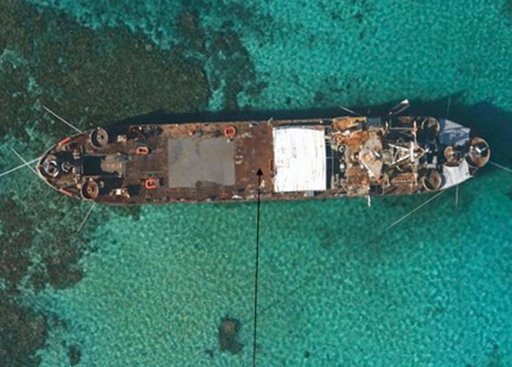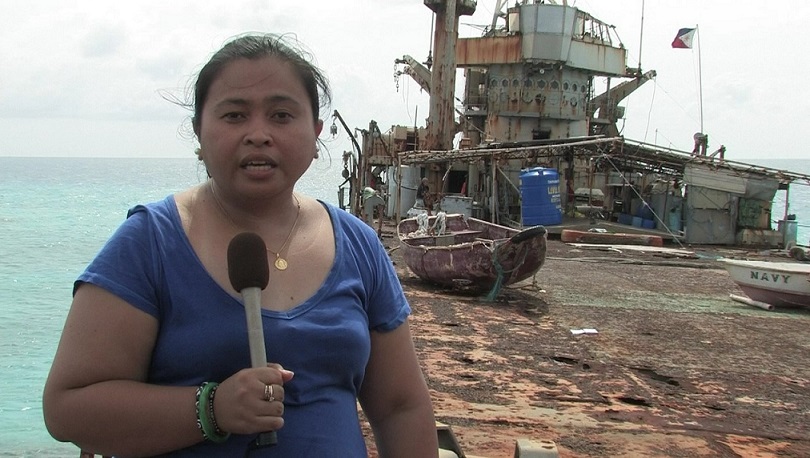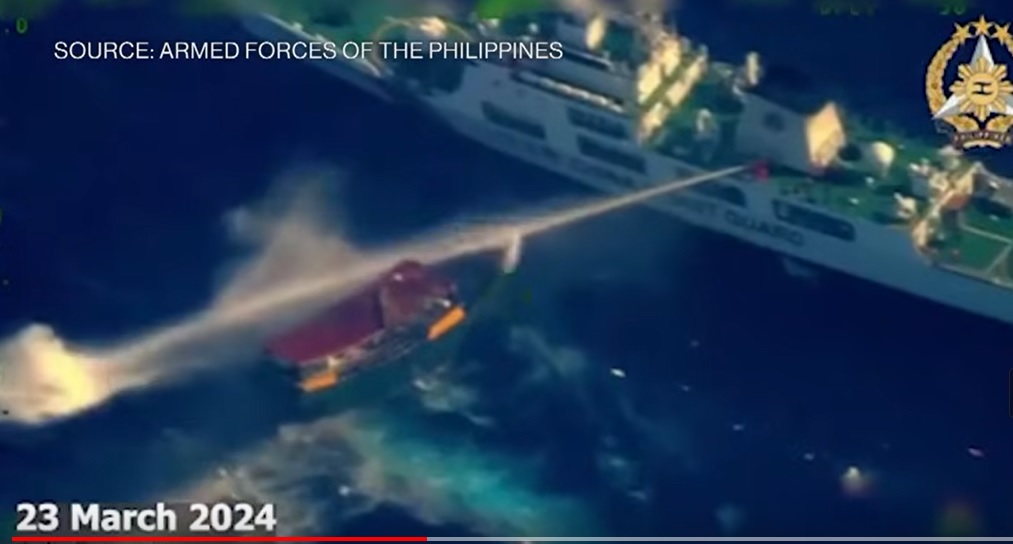The assurance of U.S. Defense Secretary Lloyd J. Austin III on Feb. 2 that the Mutual Defense Treaty is applicable on the West Philippine Sea will be tested in Ayungin Shoal as Chinese ships become more determined to block any more attempts by the Philippine Navy to repair the dilapidated BRP Sierra Madre, which is holding out as a block to China’s expansionism in the South China Sea.
The latest incident, according to the Philippine Coast Guard, was on Feb. 6 when a China Coast Guard vessel blocked a Philippine Navy ship BRP Malapascua (MRRV-4403), and directed a military-grade laser at the vessel.
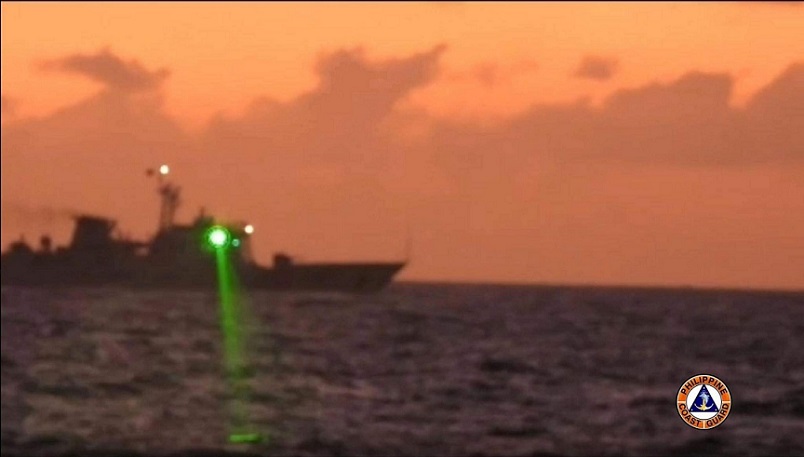
The BRP Malapascua was assisting a rotation and resupply mission to Ayungin Shoal for the Marines manning the BRP Sierra Madre.
Ayungin Shoal, a low- tide elevation (meaning, it’s underwater during high tide) in the Spratly Islands of the South China Sea, is 105 nautical miles west of Palawan. So, it is part of the 200-nautical-mile exclusive economic zone (EEZ) and continental shelf of the Philippines. Its international name is Second Thomas Shoal. China calls it Ren’ai Reef.
China claims it under its encompassing nine-dash line map, which has been declared null and void by the Permanent Court of Arbitration (PCA).
The Chinese Foreign Ministry spokesman, Wang Wenbin, was defiant and insistent when asked in a press conference in Beijing on Feb. 13 about the Feb. 6 laser-pointing act. He said: “The Ren’ai Reef is part of China’s Nansha Islands. On Feb. 6, a Philippine Coast Guard vessel intruded into the waters off the Ren’ai Reef without Chinese permission. In accordance with China’s domestic law and international law, including the United Nations Convention on the Law of the Sea (UNCLOS), the China Coast Guard ship upheld China’s sovereignty and maritime order and acted in a professional and restrained way. We hope the Philippine side will respect China’s territorial sovereignty and maritime rights and interests in the South China Sea and avoid taking any actions that may exacerbate disputes and complicate the situation.”
Directing blinding military grade laser at Philippine Navy ship
Retired Supreme Court Justice Antonio Carpio, an expert on matters on South China Sea issue, raised the alarm on the use by China’s coast guard vessels of military grade lasers to enforce their nine-dash line claim.
In a statement, Carpio said: “The use of lasers that causes permanent blindness is a prohibited weapon under the 1998 Protocol on Blinding Laser Weapons to which China and the Philippines are parties. Laser weapons can either cause permanent or temporary blindness. If it causes permanent blindness, the laser weapon is outlawed and cannot be used as a weapon by militaries. If it causes only temporary blindness, it can be used as a weapon by militaries.”
Thus, he said, “The laser weapon, even if it causes only temporary blindness, is still a weapon or an arms that can be used in an attack that qualifies the attack as an armed attack under the Mutual Defense Treaty.”
MDT covers West Philippine Sea
Carpio’s statement brings us to Austin’s categorical assurance in a joint press conference with Defense Secretary Carlito Galvez during his Manila visit last Feb. 2. He said: “Today, Secretary Galvez and I also reaffirmed our Mutual Defense Treaty commitments, and we’d note that the Mutual Defense Treaty applies to armed attacks on either of our Armed Forces, public vessels or aircraft anywhere in the South China Sea or the West Philippine Sea. We discussed concrete actions to address destabilizing activities in the waters surrounding the Philippines, including the West Philippine Sea, and we remain committed to strengthening our mutual capacities to resist armed attack.”
Whereas in the past years, American officials were noncommittal about the applicability of MDT in case of armed conflict in the South China Sea because the treaty was signed (1951) before the Philippines registered its claim on an area in the Spratlys in the South China Sea, recent statements emphasize that it covers armed attacks in the South China Sea.
Austin was more specific by stating “West Philippine Sea,” adding that “these efforts are especially important as the People’s Republic of China continues to advance its illegitimate claims in the West Philippine Sea.”
Carpio said the use by China’s coast guard of lasers that temporarily blinded Philippine Coast Guard personnel constitutes an armed attack on a Philippine public vessel. “The Philippines can thus invoke the MDT,” he said.
However, the retired justice said that before the Philippines invokes the MDT, the government should first coordinate with the U.S. and issue “a joint statement that future use by Chinese coast guard vessels of laser weapons on Philippine public vessels or aircraft will trigger the operation of the MDT.”
In an interview with journalist Christian Esguerra on Tuesday, Carpio tempered the excitement of those who want to go to war with China side by side with American soldiers, by drawing attention to the phrase in the MDT “in accordance with its constitutional processes.”
That means U.S. President Joe Biden will have to seek the approval of Congress before he can send American troops to come to the aid of the Philippines in an armed conflict in the South China Sea. That process can take a long time.
But Carpio said under the U.S. War Powers Act, if U.S. forces, vessels or military ships are attacked, the president can order within 90 days to retaliate and to use military force to engage the enemy.
BRP Sierra Madre in Ayungin Shoal
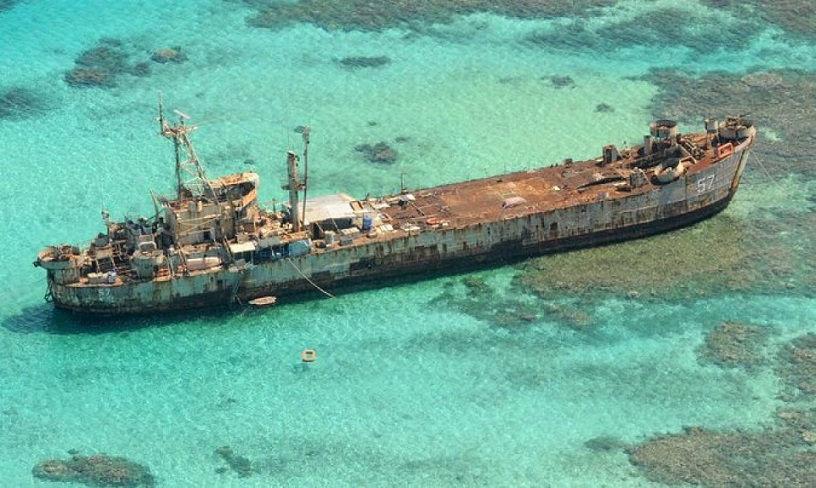
BRP Sierra Madre was originally a World War II vintage US Landing Ship Tank (LSTs). It saw action during the Vietnam War as USS Harnett County. In 1976, it was transferred to the Philippine Navy.
In 1999, the Philippine Navy deliberately grounded the 100 meter-long BRP Sierra Madre on Ayungin Shoal, 40 kilometers away from Mischief Reef which China has occupied and started building structures since 1995.
Besides serving as a military outpost, the BRP Sierra Madre has become a symbol of resistance to China’s expansive claim in the South China Sea. Manned by less than 10 members of the Philippine Marines, it is a source of annoyance to China, whose officials have several times asked Philippine officials to remove the rusting vessel.
Carpio says although BRP Sierra Madre in its dilapidated state cannot anymore sail, it is still in the Philippines’ roster of active ships. “If the Chinese attack it, we can invoke the MDT. That’s why they don’t attack (BRP Sierra Madre). They know the consequence. “
Every month, a Philippine Coast Guard vessel, escorted by Philippine Navy ships, brings food and supply to the soldiers. Chinese ships patrolling the area makes sure that Philippine ships do not carry construction materials for repair of BRP Sierra Madre. The Philippine Coast Guard and Navy personnel, on the other hand, have to repair and do some reinforcement on BRP Sierra Madre, or else it will continue to decay and sink, which is what the Chinese want and are just waiting to happen so they can occupy Ayungin Shoal and control that area which is part of the Philippines’ EEZ.
And that’s the reason why they have become more aggressive in blocking the resupply of goods and materials to BRP Sierra Madre in Ayungin Shoal.
Why is the Chinese stepping up the pressure on the Marcos government? Does it have something to do with Marcos giving the U.S. additional EDCA facilities, including two in the North, that could serve as launching pad for U.S. forces if China invades Taiwan? More in the next column.
The views in this column are those of the author and do not necessarily reflect the views of VERA Files.
